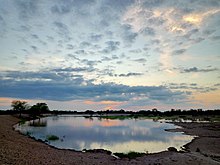Johad
Johads also cater to resident and seasonal migrant birds as well as wildlife animals from the nearby bani (forest).
In many parts, specially in dry state of Rajasthan, the annual rainfall is very low (between 450 and 600 mm) and the water can be unpleasant to drink.
A similar structure to a johads, called a khadin, consists of a very low and long earthen bund in the Jaisalmer district.
[5][6] Smaller cemented water tanks called taankas in parts of Rajasthan are also sometimes mistakenly referred to as johads.
Matsya Purana, a Hindu text, has a Sanskrit language shloka (hymn), which explains the importance of reverence of ecology in Hinduism.
"[7] Gramadevata (village deity) temples and Jathera shrines of pitrs for ancestral worship are usually found on the banks of johads, which also have ghats for the sacred rituals, bathing and other religious, social and practical human activities.
[1][2][3][4] 2019 Atal Bhujal Yojana (Atal groundwater scheme), a 5 years (2020-21 to 2024-25) scheme costing INR 6 billion (US$85 million) for managing demand side with village panchayat level water security plans entailing johad rejuvenation (wetland) and groundwater recharge, was approved for implementation in 8,350 water-stressed villages across 7 states, including Haryana, Rajasthan, Gujarat, Madhya Pradesh, Uttar Pradesh, Karnataka, and Maharashtra.
In 1985, volunteers from the Tarun Bharat Sangh (TBS), a voluntary organization led by Rajendra Singh, came to Alwar.
The Alwar District had once thrived, but logging, mining, and other industrial activities resulted in land degradation that intensified flooding and droughts.
Taanka or Tanki is a rain-fed water storage in the arid areas of the Indian subcontinent, such as Rajasthan, specially in the bagar tract.




